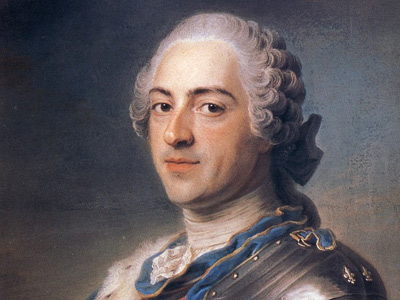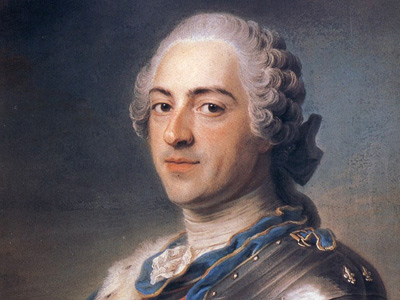The Government of Maupeou and the Triumvirate (1770–1774)
The King passed the leadership of the government to a triumvirate of three conservative ministers, led by his Chancellor, René de Maupeou, who had been President of the Parlement from 1763 to 1768. Maupeou and two other conservative ministers, Abbot Terray for finance and the Duc d'Aiguillon for foreign affairs and war, took charge of the government. They became known as "The Triumvirate".
Suppression of the Parlements
The first priority of Maupeou was to bring the unruly Parlements under control, and to continue with his program for the modernization of the state. Most of the members of the Parlement of Paris were on a virtual strike, refusing the render justice or approve the King's decrees. On 21 January 1771, royal agents and musketeers arrived at the homes of each of the Parlement members, informing them that their positions were confiscated and ordering them to leave Paris and return to their home provinces,and not to leave them. This was followed in February by an even more radical measure; the regional Parlements were replaced as the high courts of civil justice by six new regional high councils, to judge serious criminal and civil cases.Another decree announced the abolition of the high fees demanded by the Parlements for resolving civil cases, which were the source of their members' income; civil justice was to be rendered without charge. The powers of the Parlement of Paris alone were largely unchanged. Without the provincial parliaments, the government was able enact new laws and taxes without opposition. However, after the King's death, the nobility demanded and received the restoration of the regional parliaments.
Finances
Abbot Terray was a nominally a priest, though his government career was entirely secular, and his personal life was considered scandalous. He was an efficient and relentless tax collector; he opened a school to train tax inspectors, and worked to see that taxes were imposed and collected with the same precision and vigor in all regions, without interference from the local nobility. When he first took his position, the state had a budget deficit of 60 million livres, and a long-term debt of 100 million livres. By 1774, revenues had been increased by 60 million livres and the debt reduced to 20 million livres. He also reimposed the regulation of the price of grain, which had been freed in 1763 and 1764; these controls were an issue which would disturb the government and provoke agitation until the French The Kingdom of France is the historiographical name or umbrella term given to various political entities of France in the medieval and early modern period. It was one of the most powerful states in Europe since the High Middle Ages. It was also an early colonial power, with possessions around the world. Colonial conflicts with Great Britain led to the loss of much of its North American holdings by 1763. The Kingdom of France adopted a written constitution in 1791, but the Kingdom was abolished a year later and replaced with the First French Republic. Revolution.
The Kingdom of France is the historiographical name or umbrella term given to various political entities of France in the medieval and early modern period. It was one of the most powerful states in Europe since the High Middle Ages. It was also an early colonial power, with possessions around the world. Colonial conflicts with Great Britain led to the loss of much of its North American holdings by 1763. The Kingdom of France adopted a written constitution in 1791, but the Kingdom was abolished a year later and replaced with the First French Republic. Revolution.
Foreign Affairs
The foreign affairs post had been left vacant by Choiseul, who acted as his own foreign minister. Following the dismissal of Choiseul, the King, encouraged his cousin and ally Charles III of Spain The Spanish Empire was a colonial empire governed by Spain and its predecessor states between 1492 and 1976. One of the largest empires in history, it was the first to usher the European Age of Discovery and achieve a global scale, controlling vast territory. It was one of the most powerful empires of the early modern period, reaching its maximum extent in the 18th century. to settle the crisis over the Falkland Islands, and to avoid a war. Choiseul, in his focus on a war with Britain
The Spanish Empire was a colonial empire governed by Spain and its predecessor states between 1492 and 1976. One of the largest empires in history, it was the first to usher the European Age of Discovery and achieve a global scale, controlling vast territory. It was one of the most powerful empires of the early modern period, reaching its maximum extent in the 18th century. to settle the crisis over the Falkland Islands, and to avoid a war. Choiseul, in his focus on a war with Britain The Kingdom of Great Britain was a sovereign country in Western Europe from 1 May 1707 to the end of 31 December 1800. The state was created by the 1706 Treaty of Union and ratified by the Acts of Union 1707, which united the kingdoms of England (which included Wales) and Scotland to form a single kingdom encompassing the whole island of Great Britain and its outlying islands, with the exception of the Isle of Man and the Channel Islands., had completely ignored the rest of Europe, and had no ambassador in Vienna, while Russian Empire
The Kingdom of Great Britain was a sovereign country in Western Europe from 1 May 1707 to the end of 31 December 1800. The state was created by the 1706 Treaty of Union and ratified by the Acts of Union 1707, which united the kingdoms of England (which included Wales) and Scotland to form a single kingdom encompassing the whole island of Great Britain and its outlying islands, with the exception of the Isle of Man and the Channel Islands., had completely ignored the rest of Europe, and had no ambassador in Vienna, while Russian Empire Russian Empire was an empire and the final period of the Russian monarchy from 1721 to 1917, ruling across large parts of Eurasia. The rise of the Russian Empire coincided with the decline of neighbouring rival powers: the Swedish Empire, the Polish–Lithuanian Commonwealth, Qajar Iran, the Ottoman Empire, and Qing China. Russia remains the third-largest empire in history, surpassed only by the British Empire and the Mongol Empire. and Prussia, without French protest, were in the process of dividing up an old French ally, Poland. Another ally of France, Sweden, was also threatened with division between Russia and Prussia
Russian Empire was an empire and the final period of the Russian monarchy from 1721 to 1917, ruling across large parts of Eurasia. The rise of the Russian Empire coincided with the decline of neighbouring rival powers: the Swedish Empire, the Polish–Lithuanian Commonwealth, Qajar Iran, the Ottoman Empire, and Qing China. Russia remains the third-largest empire in history, surpassed only by the British Empire and the Mongol Empire. and Prussia, without French protest, were in the process of dividing up an old French ally, Poland. Another ally of France, Sweden, was also threatened with division between Russia and Prussia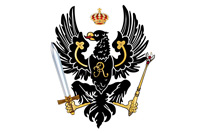 The Kingdom of Prussia was a German kingdom that constituted the state of Prussia between 1701 and 1918. It was the driving force behind the unification of Germany in 1871 and was the leading state of the German Empire until its dissolution in 1918. Although it took its name from the region called Prussia, it was based in the Margraviate of Brandenburg. Its capital was Berlin., when its King died in 1771. The Prince Royal, Gustav III of Sweden was staying in Paris at the time. He had a long meeting with Louis XV, who promised to support him. With French funding, and assistance from Louis's personal secret intelligence service, the Secret de Roi, Gustave III returned to Stockholm. On 19 August 1772, at the head of the royal guard, he took the Swedish Senate prisoner, and two days later was proclaimed King by the Diet. Russia and Prussia, occupied with the division of Poland, protested but did not intervene.
The Kingdom of Prussia was a German kingdom that constituted the state of Prussia between 1701 and 1918. It was the driving force behind the unification of Germany in 1871 and was the leading state of the German Empire until its dissolution in 1918. Although it took its name from the region called Prussia, it was based in the Margraviate of Brandenburg. Its capital was Berlin., when its King died in 1771. The Prince Royal, Gustav III of Sweden was staying in Paris at the time. He had a long meeting with Louis XV, who promised to support him. With French funding, and assistance from Louis's personal secret intelligence service, the Secret de Roi, Gustave III returned to Stockholm. On 19 August 1772, at the head of the royal guard, he took the Swedish Senate prisoner, and two days later was proclaimed King by the Diet. Russia and Prussia, occupied with the division of Poland, protested but did not intervene.
Last Years in Versailles
In the last years of his reign, the court of Versailles was a theater of manners. Marie-Antoinette, a resident since her marriage, had difficulty disguising her dislike for the King's mistress, Madame du Barry. The King constructed a set of luxurious rooms for Madame du Barry on the floor above his offices; Madame du Barry also reigned in the Petit Trianon, which the King had built for Madame de Pompadour, and in the Pavillon de Louveciennes, also built for Madame de Pompadour. The Court was divided between those who welcomed Madame du Barry, and those of the older aristocracy, such as the Duc de Choiseul plus Marie-Antoinette, who scorned her. The King continued his grand construction projects, including the opera theater of the Palace of Versailles, completed for the celebration of the wedding of the Dauphin and Marie-Antoinete, and the new Place Louis XV (now Place de la Concorde) in Paris, whose centerpiece was an equestrian statue of the King, modeled after that of Louis XIV on the Place Vendôme.
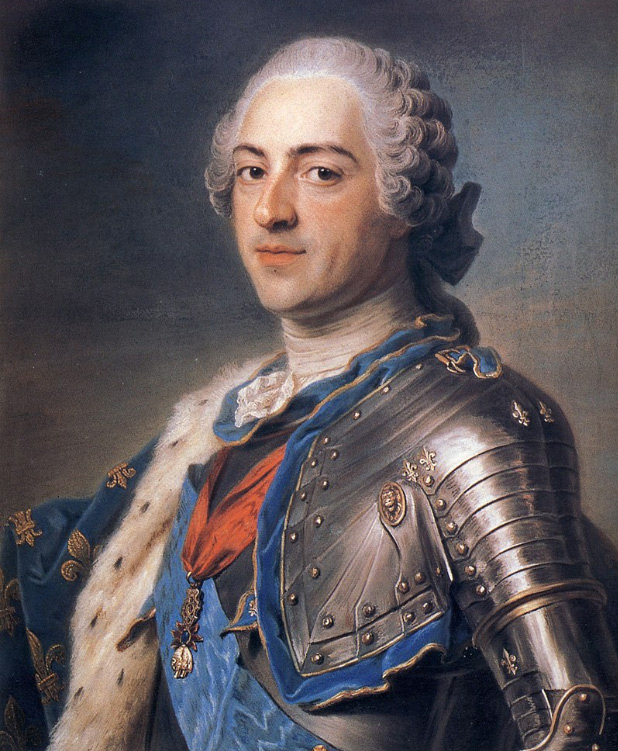
Death
On 26 April 1774, the King left for the Petit Trianon with Madame du Barry and several nobles from his entourage, and reported that he felt ill. He participated in the hunt the next day, but rode in his carriage instead of on horseback. That evening he was still feeling ill, and sent for the Court physician, Le Mariniére. At the surgeon's insistence, the King was brought back to the Palace of Versailles for treatment, along with Madame du Barry and the others. The King was attended by six physicians, six surgeons, each of whom took his pulse and gave his diagnosis. He was bled three times by the surgeons, without effect. When some red eruptions appeared on his skin, the doctors first diagnosed petite variole, or smallpox, which caused optimism, since the patient and doctors both believed he had already had the illness. The members of the family, particularly the Dauphin and Marie-Antoinette, were asked to leave, since they had not already had the illness, and had no immunity. Madame du Barry remained with him. As the hours passed, the red eruptions of the disease grew worse, and the doctors began to fear for his life. On the morning of 1 May, the Archibishop of Paris arrived, but was kept out of the King's room to avoid alarming him. The King remained conscious and cheerful. However, on 3 May, he studied the eruptions on his hands, summoned the Archbishop, and announced, "I have the petite variole." The Archibishop instructed him to prepare for the final rites. That night, he summoned Madame du Barry, informed her of the diagnosis, and said, "We cannot recommence the scandal of Metz. If I had known what I know now, you would not have been admitted. I owe it to God and to my people. Therefore, you have to leave tomorrow." On 7 May, he summoned his confessor and was given the final rites. The illness continued its course; one visitor on 9 May, the Duc de Croy, said the King's face resembled, with the darkening of the eruptions of the smallpox, "a mask of bronze". Louis died at 3:15 in the morning on 10 May 1774.
HISTORY
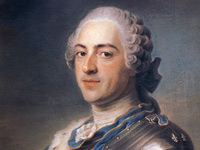
RESOURCES
This article uses material from the Wikipedia article "Louis XV of France (1710-1774)", which is released under the Creative Commons Attribution-Share-Alike License 3.0.
© Stories Preschool. All Rights Reserved.
